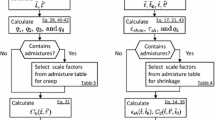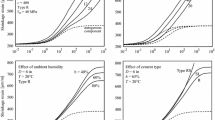Abstract
Model B3 for creep and shrinkage prediction in the design of concrete structures, presented as a RILEM Recommendation inMater Struct.28 (1995) 357–365, is calibrated by a computerized data bank comprising practically all the relevant test data obtained in various laboratories throughout the world. The coefficients of variation of deviations of the model from the data are distinctly smaller than for the latest CEB model, and much smaller than for the previous ACI model (which was developed in the mid-1960's). The effect of concrete composition and design strength on the model parameters is identified as the main source of error. The model is simpler than the previous models (BP and BP-KX) developed at Northwestern University, yet it has comparable accuracy and is more rational.
Similar content being viewed by others
References
Bažant, Z. P. and Baweja, S., ‘Creep and shinkage characterization for design of concrete structures-Model B3′, Structural Engineering Report 94-10/603c (Northwestern University, 1994).
Bažant, Z. P. and Panula, L., ‘Practical prediction of time-dependent deformations of concrete’, Parts I–VIMater. Struct. 11 (1978) 307–316. 317–328. 425–434;12 (1979) 169–183.
Bažant, Z. P. and Kim, Joong-Koo., ‘Improved prediction model for time-dependent deformations of concrete’, ‘Part 1-Shrinkage’,-ibid.Mater. Struct. 24 (1991) 327–345; ’Part 2-Basic creep’,Ibid. Mater. Struct. 24 (1991) 409–442; ‘Part 3-Creep at drying’,Ibid. Mater. Struct. 24 (1991). 21–28; ‘Part 4-Temperature effects’,Ibid. Mater. Struct. 25 (1992) 84–94; ‘Part 5-Cyclic load and cyclic humidity’,Ibid. Mater. Struct. 25 (1992).
Bažant, Z. P., Panula, L., Kim, Joong-Koo. and Xi, Y., ‘Improved prediction model for time-dependent deformations of concrete: Part 6-Simplified code-type formulation’,-Ibib. 25 (1992) 219–223.
RILEM TC-107, ‘Guidelines for characterizing concrete creep and shrinkage in structural design codes or recommendations’,Mater. Struct. 28 (1995) 52–55; (b) RILEM TC 69, ‘Conclusions for structural analysis and for formulation of standard design recommendations’, in ‘Mathematical Modeling of Creep and Shrinkage of Concrete’, edited by Z. P. Bažant, Chap. 6 (Wiley, New York, 1988); reprinted inMater. Struct. 20 (1987) 395–398; and inACI Mater. J. 84 (1987) 578–581
Bažant, Z. P. and Baweja, S., ‘Creep and shrinkage model for analysis and design of concrete structures’, RILEM Recommendation,Mater. Struct. 28 (1995) 357–365.
Bažant, Z. P., Xi, Y. and Baweja, S., ‘Improved prediction model for time-dependent deformations of concrete: Part-7, Short form of BP-KX model, statistics and extrapolation of short-time data’,-Ibid. 26 (1993) 567–574.
‘Prediction of creep, shrinkage and temperature effects in concrete structures’, ACI 209 R-92 (American concrete Institute, Detroit, 1992).
‘CEB-FIP Model Code, 1990, Design Code’ (Thomas Telford, London, 1990).
Gardner, N. J. and Zhao, J. W., ‘Creep and shrinkage revisited’,ACI Mater. J. 90 (1993) 236–246; Discussion by Bažant, Z. P. and Baweja, S.,Ibid. 91 (1994) 204–216.
Keeton, J. R., ‘Study of creep in concrete’, Technical Reports R333-I, R333-II, R333-III (US Naval Civil Engineering Laboratory, Port Hueneme, California, 1965).
Wallo, E. M., Yuan, R. L., Lott, J. L. and Kesler, C. E., ‘Sixth progress report on prediction of creep in structural concrete from short time tests’, T & AM Report No. 658. (Department of Theoretical and Applied Mechanics, University of Illinois at Urbana, 1965).
L'Hermite, R. G. and Mamillan M., “Influence de la dimension des éprouvettes sur le retrait’,Ann. Inst. Techn. Bâtiment Trav. Publics 23 (1970) 5–6.
L'Hermite, R. G., Mamillan, M. and Lefévre, C., ‘Nouveaux résultats de recherches sur la déformation et la rupture du béton’,-Ibid. 18 (1965) 323–360.
Wittmann, F. H.. Bažant, Z. P., Alou, F. and Kim, J. K., ‘Statistics of shrinkage test data’,Cement Concr. Aggreg. ASTM 9 (1986) 129–153.
Hilsdorf, H. K., ‘Unveröffentlichte Versuche an der MPA München’, private communication, 1980.
Kommendant, G. J., Polivka, M. and Pirtz, D., ‘Study of concrete properties for prestressed concrete reactor vessels’, Final Report No. UCSESM 76-3 (to General Atomic Company) (Department of Civil Engineering, University of California, Berkeley, 1976).
Rostasy, F. S., Teichen, K.-Th. and Engelke, H., ‘Beitrag zur Klärung des Zussammenhanges von Kriechen und Relaxation bei Normal-beton’, Amtliche Forschungs- und Materialprüfungsanstalt für das Bauwesen, Heft 139 (Otto-Graf-Institut, Universität Stuttgart, 1972).
Hansen, T. C. and Mattock, A. H., ‘Influence of size and shape of member on the shrinkage and creep of concrete’,ACI J. 63 (1977) 267–290.
Troxell, G. E., Raphael, J. E. and Davis, R. W., ‘Long-time creep and shrinkage tests of plain and reinforced concrete’,Proc. ASTM. 58 (1958) 1101–1120.
Russell, H. and Burg, R., Private communication, Construction Technology Laboratories, Skokie, Illinois.
Browne, R. D., ‘properties of concrete in reactor vessels’, in ‘Proceedings of the Conference on Prestressed concrete Pressure Vessels’, (Institution of Civil Engineers, London, 1967) pp. 11–31.
Hannant, D. J., ‘Strain behaviour of concrete up to 95°C under compressive stresses’,-Ibid. “, pp. 57–71.
Takahashi, H. and Kawaguchi, T., ‘Study on time-dependent behaviour of high-strength concrete (Part 1). ‘Application of the Time-Dependent Linear Viscoelasticity Theory of Concrete Creep Behaviour”, Report No 21 (Ohbayashi-Gumi Research Institute, Tokyo, 1980) pp. 61–69.
Mandel, J., ‘The Statistical Analysis of Experimental Data’, (Wiley-Interscience, New York, 1964).
Tsubaki, T., ‘Sensitivity of factors in relation to prediction of creep and shrinkage of concrete’, in ‘Creep and Shrinkage of Concrete’, Proceedings of 5th International RILEM Symposium (Con Creep 5), Barcelona, Spain (Chapman & Hall, London, 1993) pp. 611–622.
Neville, A. M., Dilger, W. H. and Brooks, J. J., ‘Creep of Plain and Structural Concrete. (Construction Press, London, 1983).
Granger, L. and Bažant, Z. P., ‘Effect of composition on basic creep of concrete’, Structural Engineering Report No. 93-8/603e (Northwestern University Evanston, Illinois, 1993);ASCE J. Engng Mech., in press.
Author information
Authors and Affiliations
Rights and permissions
About this article
Cite this article
Bažant, Z.P., Baweja, S. Justification and refinements of model B3 for concrete creep and shrinkage 1. statistics and sensitivity. Materials and Structures 28, 415–430 (1995). https://doi.org/10.1007/BF02473078
Issue Date:
DOI: https://doi.org/10.1007/BF02473078




